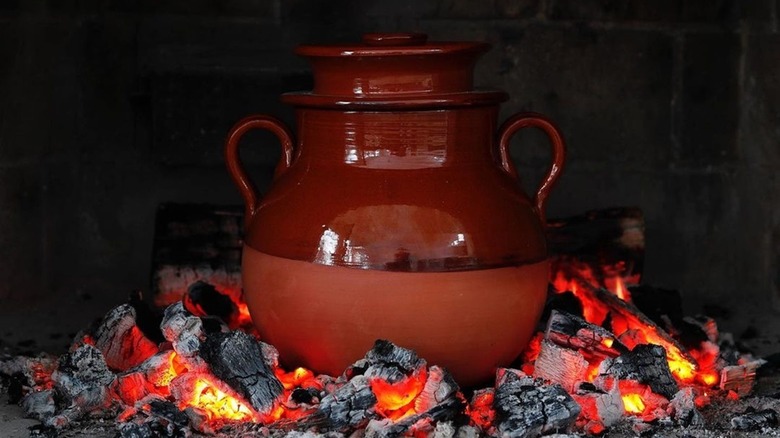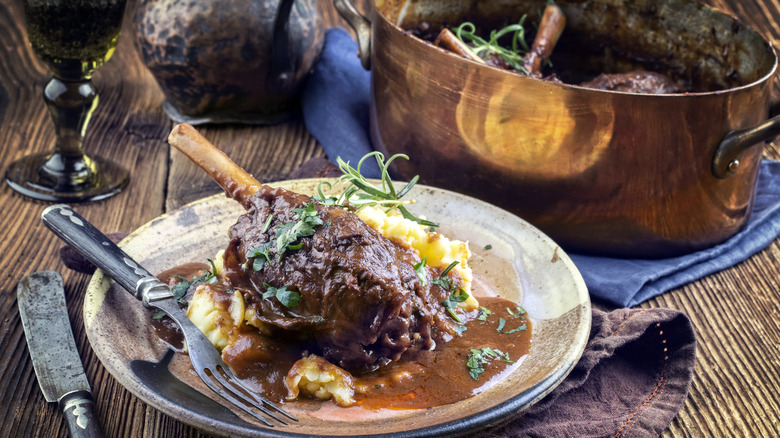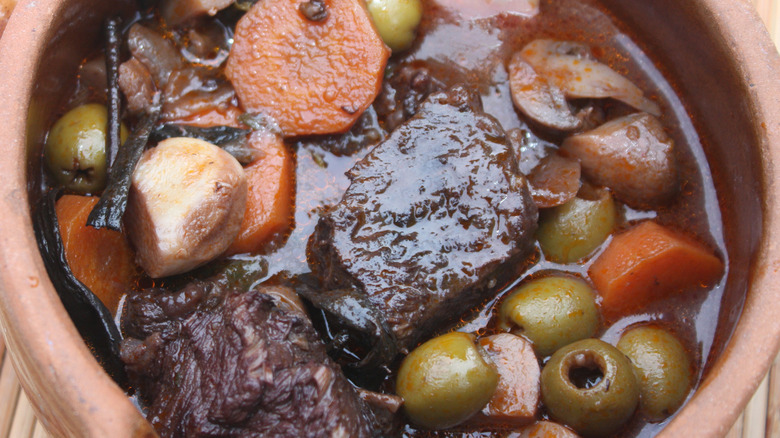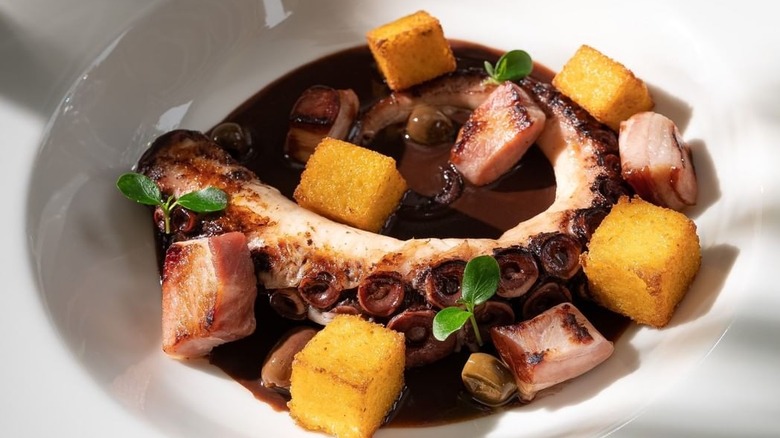The Special Cooking Pot Used For Classic French Daube Beef Stew
From paella to tagine, certain foods are interlinked with their cooking vessel. Achieving such a precise balance of texture and flavor for such dishes is difficult without the correct pot or pan. The specially designed cookware usually offers a method of heat application that's integral to the food's quality.
In France, one such niche cooking contraption is the daubière. Utilized for slow cooking, the unique pot turns a wide range of proteins melt-in-your-mouth tender, all the while using only a little liquid. Most famously used for daube beef stew, the pot can also be employed for everything from turkey to octopus.
While daube recipes cooked in a daubière take some effort — with an extensive range of ingredients and long cooking times — the rewards are more than worthwhile. The result has a beautiful melding of flavor and super tender texture that can be difficult to replicate otherwise. So, let's dive into the variations of this vessel and how to use one when preparing daube.
What is a daubière?
Daubières refer to both copper and clay cooking vessels, which emerged during a period when French cuisine was still mostly done on hot coals. From medieval times onwards, the majority of French households contained a hearth on which cooking took place. These fireplaces were accompanied by earthenware vessels, which gave rise to dishes like pot-au-feu, which translates as pot on the fire.
The daubière originated towards the end of this period, in the 19th century, right before oven-cooking started to emerge. The cooking pot came as an evolution of the braisière, a large pot meant to be buried in coals, like an early oven. Its defining feature was a rimmed indentation on the top, used to collect moisture, thereby enabling a cooler top and a moist atmosphere in the interior.
Confusingly, the name references two types of vessels, each with a different shape and composition. One is a half-glazed clay pot, with a large spherical bottom and a more slender top. Another is a copper box, much larger in size, with rounded corners, and handles. Despite their difference in form, the two function in the same manner.
The daubière creates a heat flow ideal for slow-braising
The daubière's shape allows a distinct heat regulation that's essential to making a daube. Typically, hot air rises, meaning hot steam will accumulate and become trapped at the top of most vessels. However, the daubière alters that process, creating a top that is cooler than the bottom. Grooves on the lid accumulate steam, which then cools off the vessel, thereby lowering the temperature. This cyclical process drips contained moisture coming off the stew back into the food, steadily condensing its flavor. As a result, the ingredients become tender and flavorful, despite being in only a small amount of initial liquid.
In the case of the clay vessel, the daubière has a unique glazing; only the top is coated. This ensures a non-permeable surface where the fluid we mentioned accumulates and it further enhances the system of having a hotter base and cooler top. When prepared on a slow, steady heat, this creates a perfect slow braise.
Although daubières were originally created for use with embers, they can now be employed in modern kitchen settings, too. It's advised to first heat the vessel on the stovetop, preferably over a low-lit gas flame, before transferring to an oven, where most of the cooking takes place. Since the pot may become a little less air-tight due to expansion, some add a layer of dampened parchment paper under the lid for extra insulation.
Daube is a slow-cooked stew prepared with the daubière
The daubière is most frequently utilized to prepare daube of beef à la Provençale. This dish reaches for affordable beef cuts laden with connective tissue, such as shanks, chuck, and cheeks. When slow-simmered in an aromatic base full of spices, wine, root vegetables, and other components, the stew thickens into a silky, rich creation, thanks to the meat's collagen turning into gelatin. It also makes for super tender meat. Although there are several steps in the initial phases — like browning of the beef and thickening with flour — the majority of the cooking time is hands-off.
And in addition to beef, other proteins can go into the daubière, too. Lamb daube results in flavors reminiscent of a tagine. And other traditional French recipes reach for anything from rabbit to veal, and octopus, which is a particularly popular seafood option. No matter the protein, the pot is loaded with aromatics and some wine. And with a delicate amount of liquid, the stew is slow-cooked for hours to tender perfection. So if you're feeling adventurous, source a daubière of your own, most easily from an online purveyor, because although cooking with it takes time and effort, the resulting textures and flavors are worthwhile.



